Abstract
There is a need for improved methods to suggest whether a particular tree species is worth testing at a new location. A method is proposed which compares the climatic similarity of a potential new location with conditions within a species natural distribution, and identifies if similar sites exist. When information is available, climatic comparisons can also be made with successful sites of introduction outside the natural range. A program is described which carries out these comparisons and Eucalyptus citriodora is analysed as an example. It is concluded that the method offers advantages over systems which describe climatic requirements simply as ranges of suitable conditions. The importance of soil factors is recognised and ways in which these could be analysed along with climatic factors are noted. The integration of the similarity analysis into existing databases or its development as part of a complete expert system are discussed.
Similar content being viewed by others
References
Ahmed P (1989) Eucalyptus in agroforestry: its effects on agricultural production and economics. Agroforestry Systems 8: 31–38
Booth TH (1985) A new method for assisting species selection. Commonw For Rev 64: 241–250
Booth TH, Nix HA, Hutchinson MF and Jovanovic T (1988) Niche analysis and tree species introduction. For Ecol Manage 23: 47–59
Booth TH, Stein JA, Nix HA and Hutchinson MF (1989) Mapping regions in Africa climatically suitable for particular species. For Ecol Manage 28: 19–31
Brieman L, Friedman JH, Olshen RA and Stone CJ (1984) Classification and Regression Trees. Wadworth Statistics/Probability Series, Wadsworth, Belmont
Brown AG, Wolf LJ, Ryan PA and Voller P (1989) TREDAT: a tree crop database. Aust For 52: 23–29
Buchanan BG and Duda RO (1983) Principles of rule-based expert systems. In: MC Yovits ed, Advances in Computers, Vol 2. Academic Press, New York, pp 163–216
Busby JR (1986) A bioclimatic analysis of Nothofagus cunninghamii (Hook.) Oerst. in south-eastern Australia. Aust J Ecol 11: 1–7
Carlowitz PG von (1986) Multipurpose Tree and Shrub Seed Directory. ICRAF, Nairobi
Carlowitz PG von (1987) ICRAF's multipurpose tree and shrub information system. Agroforestry Systems 5: 319–338
Chippendale GM and Wolf L (1984) EUCALIST: Computerized data retrieval system for Eucalyptus (Myrtaceae). Aust For Res 14: 147–152
Davidson J (1988) Breeding eucalypts in tropical countries. In Anon. ed, The International Forestry Conference for the Australian Bicentenary. vol V. Australian Forest Development Institute, Launceston 1–21
Davidson J and Nuruzzaman Khan (in press) Computerized matching of tree species to sites. FAO/UNDP Project BGD/79/017 Assistance to the Forestry Sector, Working Paper, FAO, Rome
Gower JC (1971) A general coefficient of similarity and some of its properties. Biometrics 27: 857–871
Hutchinson MF (1984) A summary of some surface fitting and contouring programs for noisy data. CSIRO Division of Mathematics and Statistics, Consulting Report ACT 84/6, Canberra
Midgley SJ (1988) Australian Tree Seed Centre — a window to the resource. Proceedings of the International Forestry for Conference for the Australian Bicentenary. Australian Forestry Development Institute. Vol V, 1–10
Nix HA (1986) A biogeographic analysis of Australian Elapid snakes. In: R. Longmore ed, Atlas of Australian Elapid Snakes. Bureau of Flora and Fauna, Canberra, ACT, pp 4–15
Schmoldt DL and Martin GL (1986) Expert systems in forestry: utilizing information and expertise for decision making. Computers and Electronics in Agriculture 1: 233–250
Turnbull JW (1986) Multipurpose Australian Trees and Shrubs: Lesser-known Species for Fuelwood and Agroforestry. ACIAR, Canberra
Wahba G and Wendelberger J (1980) Some new mathematical methods for variational objective analysis using splines and cross validation. Mon Weather Rev 108: 1122–1143
Walker PA and Cocks KD (in press) The use of computer induction techniques to model climate-spaces of Australian plant and animal species
Webb DB, Wood PJ and Smith JP (1980) A Guide to Species Selection for Tropical and Sub-Tropical Plantations. Trop For Pap 15, Commonwealth Forestry Institute, Oxford.
Webb DB, Wood PJ, Smith JP and Henman GS (1984) A Guide to Species Selection for Tropical and Sub-Tropical Plantations. Trop For Pap 15 (2nd edition), Commonwealth Forestry Institute, Oxford
Webster R (1977) Quantitative and numerical methods in soil classification and survey. Clarendon, Oxford
Ying L-S, Levine SP, Tomellini SA and Lowry SR (1987) Self-training, self-optimizing expert system for interpretation of the infra-red spectra of environmental mixtures. Anal Chem 59: 2197–2203
Author information
Authors and Affiliations
Rights and permissions
About this article
Cite this article
Booth, T.H. A climatic analysis method for expert systems assisting tree species introductions. Agroforest Syst 10, 33–45 (1990). https://doi.org/10.1007/BF00118725
Issue Date:
DOI: https://doi.org/10.1007/BF00118725




